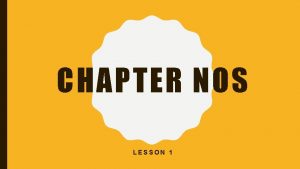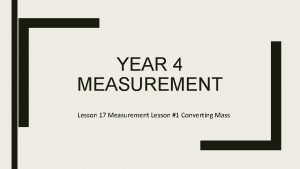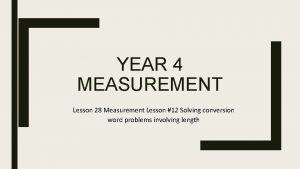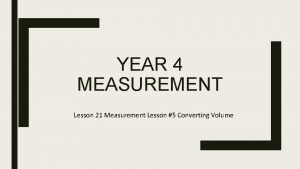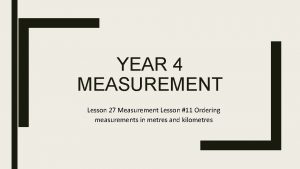YEAR 4 MEASUREMENT Lesson 20 Measurement Lesson 4








- Slides: 8

YEAR 4 MEASUREMENT Lesson 20 Measurement Lesson #4 Problem Solving with Mass

Recap – some important things to remember when problem solving with mass (weight). 1000 grams = 1 kg To convert from kilograms into grams, we multiply by 1000. To convert from grams into kilograms, we divide by 1000. One thing that weighs close to 1 kilogram would be a bunch of bananas. What other items in your house can you find that you think weigh close to 1 kilogram? See if an adult agrees with you. If you have scales, you could check to find out. One thing that weighs close to 1 gram would be a £ 5 note. What other items in your house can you find that you think weigh close to 1 gram? See if an adult agrees with you. You would need accurate scientific scales if you wanted to measure 1 gram!

Three pencils weigh 90 g. Two rubbers weigh 100 g. Put a more than, less than or equal to sign (>, <, =) to complete the comparison below. 1 pencil 1 rubber To work this out, I must divide the weight of three pencils by three, to find the weight of 1 pencil. 90 g divided by 3 = 30 g. Then I must divide the weight of two rubbers by two, to find the weight of 1 rubber. 100 g divided by 2 = 50 g weighs more than 30 g, therefore 1 rubber is heavier than 1 pencil < 1 rubber. Hint: If you find dividing hard, remember to practise using the bus stop method.

Comparing Scales Even though the arrow is further around on the Flour, we know the carrots weigh more. This is because the carrots are measured in Kilograms and the flour in grams. We know there are 1000 grams in 1 kilogram, and that the flour only weighs Somewhere between 700 and 800 grams.

Comparing Scales – Practise Which do you think weighs more? Pears or cherries?

Working out Mass– 17 kg and 400 g. What do I know about this weight together? I know it is greater than 17 kg but smaller than 18 kg because 400 g is less than 1 kg. Then, this next bit may be tricky, so don’t worry if you don’t understand it If I wanted to add exactly how much there was, I could convert the 400 g into kg by dividing it by 1000. 400 g = 0. 4 kg. 17 kg and 400 g = 17 kg + 0. 4 kg = 17. 4 kg

Working out Mass– Practise 14 kg and 500 g. What do you know about these weights together? Is it greater than 14 kg? Yes or no? Is it less than 15 kg? Yes or no? Challenge (if you’re very confident!) What is the exact weight in kg?

Now have a go at as many problem solving questions as you can. Good luck!
 Leavers poem year 2
Leavers poem year 2 Chapter 9 intellectual development in the first year
Chapter 9 intellectual development in the first year Can get spoilt in 2-3 days
Can get spoilt in 2-3 days Months of the year lesson
Months of the year lesson Understanding science worksheet answers lesson 1
Understanding science worksheet answers lesson 1 Lesson 2 measurement and scientific tools answer key
Lesson 2 measurement and scientific tools answer key Measurement and scientific tools lesson 2
Measurement and scientific tools lesson 2 Lesson outline lesson 3 describing circuits answers
Lesson outline lesson 3 describing circuits answers Kind of fault
Kind of fault





